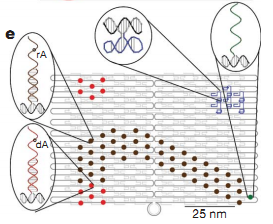DNAmazingMission: Difference between revisions
No edit summary |
|||
| Line 65: | Line 65: | ||
<div class="main" style="padding-top:10px; padding-bottom:10px"> | <div class="main" style="padding-top:10px; padding-bottom:10px"> | ||
=Inspiration= | =Inspiration= | ||
[[Image:DNAmotor.png|right|Figure 1]] | [[Image:DNAmotor.png|right|Figure 1|thumb]] | ||
[[Image:Dnamotor2.png|right|Figure 2]] | [[Image:Dnamotor2.png|right|Figure 2|thumb]] | ||
Since the first paper published by Paul W.K.Rothemund about DNA Origami in 2006, there have been intense efforts observed in the community of nanoscientists, chemists, and nanoengineers to push the field ahead. During only 5 years, DNA Origami has advanced from 2D to 3D nanostructures, from DNA Origami systems in relaxing state to systems intentionally in tension to create curves, from simple structures to sophisticate structures. DNA Origami is definitely one of most promising tools for nanoengineering today. | Since the first paper published by Paul W.K.Rothemund about DNA Origami in 2006, there have been intense efforts observed in the community of nanoscientists, chemists, and nanoengineers to push the field ahead. During only 5 years, DNA Origami has advanced from 2D to 3D nanostructures, from DNA Origami systems in relaxing state to systems intentionally in tension to create curves, from simple structures to sophisticate structures. DNA Origami is definitely one of most promising tools for nanoengineering today. | ||
<br><br>With its more than tenfold higher resolution than that of any previous techniques and its capability to create complex nanostructures from bottom up, we believe DNA Origami can be employed as the molds or platforms with connection sites at its sticky ends for other nano-devices and components. To illuminate, The rigidity of DNA Origami structures together with the stability of their sticky ends can be used to create the platforms on which DNA nanomachine can operate by hoping around sticky ends sites. We strongly believe that in the near future we may be able to construct nano-cities in which nano-motocycles go around and transport molecules to nano-factories. In fact, there have been few initial efforts to realize this vision. | <br><br>With its more than tenfold higher resolution than that of any previous techniques and its capability to create complex nanostructures from bottom up, we believe DNA Origami can be employed as the molds or platforms with connection sites at its sticky ends for other nano-devices and components. To illuminate, The rigidity of DNA Origami structures together with the stability of their sticky ends can be used to create the platforms on which DNA nanomachine can operate by hoping around sticky ends sites. We strongly believe that in the near future we may be able to construct nano-cities in which nano-motocycles go around and transport molecules to nano-factories. In fact, there have been few initial efforts to realize this vision. | ||
=Motivation= | =Motivation= | ||
Revision as of 07:11, 2 November 2011
<html><head> <style type="text/css"> .main { margin: 0 auto; width: 804px;border-style:solid; border-width:5px; }
- logo{ margin:10px 0 0 20px; display:block; background:url('http://openwetware.org/images/5/57/Banner2.png') 0 0 no-repeat; width:800px; height:200px; text-indent:-9999px;}
.navbox { position: relative; float: left; }
- menu{ background:url('http://openwetware.org/images/3/3f/Menu_bg.png') 0 0 no-repeat; width:643px; height:100px; margin:51px 0 0 78px; padding-top:100px}
- menu li{ float:left;}
- menu a{ font-size:30px; color:#000000; line-height:1.2em; text-decoration:none; letter-spacing:-1px;}
.nav1{ padding:26px 0 0 37px;} .nav2{ padding:16px 0 0 30px;} .nav3{ padding:36px 0 0 17px;} .nav4{ padding:16px 0 0 19px;} .nav5{ padding:26px 0 0 30px;}
- menu .nav1 a:hover{ color:#bb0e0e}
- menu .nav2 a:hover{ color:#ca6509}
- menu .nav3 a:hover{ color:#3f9711}
- menu .nav4 a:hover{ color:#0ca0ce}
- menu .nav5 a:hover{ color:#8606c5}
</style> </head>
<div class="extra"> <div id="page_1"> <div class="main" style="padding-top:10px; padding-bottom:10px"> <!--header --> <header> <a href="index.html" id="logo">DNAmazing asfsaf. Smart. Effective</a> <nav> <ul id="menu"> <li class="nav1"><a href="http://openwetware.org/wiki/User:NUS_Dnamazing">Home</a></li> <li class="nav2"><a href="http://openwetware.org/wiki/DNAmazingMission">Mission</a></li> <li class="nav3"><a href="http://openwetware.org/wiki/DNAmazingProcess">Process</a></li> <li class="nav4"><a href="http://openwetware.org/wiki/DNAmazingResult">Results</a></li> <li class="nav5"><a href="http://openwetware.org/wiki/DNAmazingResources">Resources</a></li> </ul> </nav> </header> <!--header end-->
</div>
</div>
</div>
</html>
Inspiration


Since the first paper published by Paul W.K.Rothemund about DNA Origami in 2006, there have been intense efforts observed in the community of nanoscientists, chemists, and nanoengineers to push the field ahead. During only 5 years, DNA Origami has advanced from 2D to 3D nanostructures, from DNA Origami systems in relaxing state to systems intentionally in tension to create curves, from simple structures to sophisticate structures. DNA Origami is definitely one of most promising tools for nanoengineering today.
With its more than tenfold higher resolution than that of any previous techniques and its capability to create complex nanostructures from bottom up, we believe DNA Origami can be employed as the molds or platforms with connection sites at its sticky ends for other nano-devices and components. To illuminate, The rigidity of DNA Origami structures together with the stability of their sticky ends can be used to create the platforms on which DNA nanomachine can operate by hoping around sticky ends sites. We strongly believe that in the near future we may be able to construct nano-cities in which nano-motocycles go around and transport molecules to nano-factories. In fact, there have been few initial efforts to realize this vision.